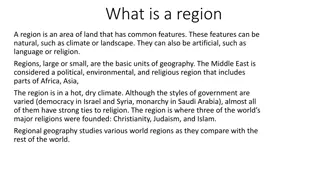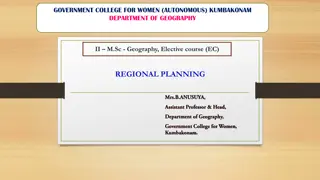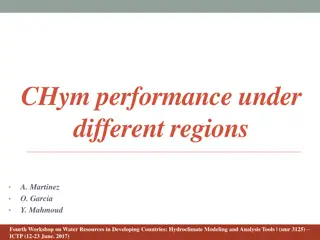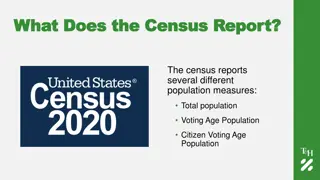Population Resource Regions and Zelinsky's Classification
Geographers have long studied the relationship between population growth and resource adequacy, leading to the concept of Population Resource Regions (PRR) by W. Zelinsky. Zelinsky identified five types of PRR based on population-resource ratios, ranging from Type A with high resource utilization potential to Type E. This classification helps understand how different regions balance technological development, resource utilization, and population growth.
Download Presentation

Please find below an Image/Link to download the presentation.
The content on the website is provided AS IS for your information and personal use only. It may not be sold, licensed, or shared on other websites without obtaining consent from the author. Download presentation by click this link. If you encounter any issues during the download, it is possible that the publisher has removed the file from their server.
E N D
Presentation Transcript
6THSEMESTER PAPER VII GROUP B (SPECIAL PAPER: POPULATION GEOGRAPHY) POPULATION RESOURCE REGIONS (AFTER ZELINSKY)
POPULATION RESOURCE REGION (PRR) Geographers have always concerned with regions and have often examined the problems of resource adequacy and population growth at great length, yet a complete lack of attempts to regionalise on the basis of population-resource ratio only points to the difficulties involved in quantification of the two main factors of population and resources. One of the useful efforts in this regard has been made by W. Zelinsky in the mid 1960s. Zelinsky recognized five types of Population Resource Region (PPR): 1. Type A 2. Type B 3. Type C 4. Type D, and 5. Type E
1. Type A Present and future possibilities of resource utilization are exceptionally high. Such countries with low population, high technological development have the potential of rapid economic development. Technical personnel are not only high in number but also consigned to countries where investments in the form of multinational corporation exists. Generally, these are the counties with vast natural resources and more than justified resource utilization capacity. USA, Canada, Australia, New Zealand, Russian Federation, Argentina and South Africa are examples of A type PRR. Other countries do not stand a chance of being designated as A type region even in the near future. On the contrary, a few of the countries belonging to the A type fold will cease to belong to this category in the future. The A type regions have come into existence only in the last century whereas all the other types claim to have a longer history.
2. Type B There are areas where technological development, resource utilization and environment sustains have been judiciously balanced. These are elite region but unlike the A type region, these countries have limited geographical extent. Natural resources are relatively low but population growth is relatively higher compared to the type A regions. There is maximum local utilization of resources. However, in terms of technological development, these countries are behind the A type region. Export of consumer durables and technological know how have sustained in these countries and paved the way for all round economic development. B type regions are improving their technological know how in order to utilize the conventional resource potential to the maximum. On account of limited geographical extent, natural resources are not in plenty in such regions. Countries included in the B type regions are West and Middle West Europe, Romania, Bulgaria, Israel and Japan. These countries were originally part of type C but elevated to their present status in the last 200 years.
3.Type C Countries belonging to this group have bountiful natural resources but are slightly backward in terms of technology. In addition geographical areas of countries belonging to this region are might extensive e.g. Brazil. Such regions are intermediate between Ackerman s European and Egyptian region with greater utilization of the natural resource and general improvement in the standard of living. Countries of such category could be finally promoted to the European type region group. However, it would be extremely difficult to stabilize the rate of economic development in these countries because population increase at a very high rate in all of these countries. In case economic development is not at par with population growth, some or all of these countries would be demoted to the next lower Egyptian type state. Such type of regions are formed of the following countries with three major geographical groupings Indo China ii. Tropical Africa i. iii. Latin America
4. Type D In terms of population resource endowment Egyptian type or type D region have a long way to go. There is a wide disparity between population growth and resource utilisation. Settlement are clustered in the narrow riverine areas. Agriculture forms the backbone of the economy. Food crops are mostly cultivated. Agricultural innovations are required to promote multiple cropping. Net sown area is limited in extent. Both capital investment and natural endowment are limited. Mineral resources are practically non-existent. Social and cultural uplift is minimum. The great majority of the population are illiterate. Egypt, Algeria, Tunisia, Morocco are the African counties that belong to type D. Greece in Europe; China, Pakistan, Bangladesh, Nepal, Sri Lanka are all examples of type D region with better population control and impressively higher economic development. China and India may be promoted to type B category.
5. Type E Hot and cold deserts, tropical marsh land and wastes are the geographical areas of the E type of PRR. Natural resources on account of inhospitable terrain and unfavourable climate are not properly utilized as a result economic development is either negligible or very low. Population growth is minimum. However, with the improvement of technology E type region can experience overall economic development and can be upgraded to the C or D type regional characteristics. .
The End The End























